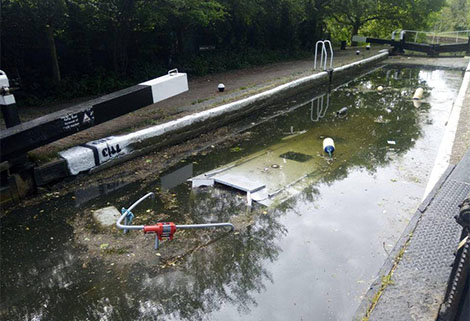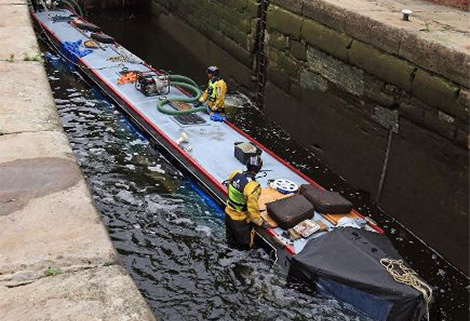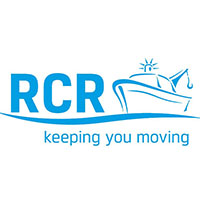managing lock cills
some useful advice from rcr
Every year, lock cills catch boaters unaware, no matter how experienced they are. Once a vessel’s caught on a cill, it causes the rudder to pop out of the cup, which is easily resolved. However in many cases it results in damage to the skeg, rudder and bearings, and the boat needing to be towed and dry-docked to have the damage repaired. There’s also a risk of taking on water and the vessel sinking.

River Canal Rescue chief rescue co-ordinator, Pete Barnett, explains what to do if your boat’s caught on a cill: “Cills protrude below the water, close to the top gates of most canal locks. If you’re travelling downhill in the lock chamber and your stern, ie rudder, gets caught on the cill, when the water recedes only the bow of your boat will lower with the water level, leaving the stern raised up. Sinking or capsizing can happen in seconds.
“If you’re aware the stern’s caught, close the bottom gate paddles to stop the water receding further and slowly open the top gate paddles to refill the lock. To stay safe in the lock, position yourself centrally, and where possible, keep the engine running with a centre line to maintain the position while you tie off.
“A boat travelling uphill can equally get its bow stuck on a projection under the top gate, causing the stern only to rise with the water level. If this happens, close the top gate to prevent the lock filling and open the bottom gate paddles to allow the water level to fall.”
Simple oversights such as being unaware of the position of a lock cill can cause devastating consequences. If the worst does happen, Pete recommends:
“If your boat’s rapidly taking on water, ensure everyone in your crew is safe and contact the Canal & River Trust, they’ll send out a team to assess the site, contain pollution and ensure your boat isn’t causing a navigational hazard.
“If your boat’s on the River Thames you’ll need to contact the Environment Agency as the CRT does not have jurisdiction. In either case, the EA and CRT will work in tandem with recovery specialists to get your boat moved as quickly as possible."

“If you own the boat, you’re responsible for finding someone to raise your vessel, arrange what needs to be done and liaise with the authorities. While you’re free to use your own contractors, if you need to bring plant/lifting equipment onsite or use non-emergency service divers, the contractors will have to meet the CRT’s/EA’s risk management requirements; otherwise they’ll not be given permission to raise the vessel.
“RCR is a CRT pre-authorised salvage specialist which means we can start the salvage straight away. Most insurance companies expect you to take action to mitigate loss in situations like this and a fast recovery reduces the amount of damage a vessel suffers, helping to keep insurance claims low.
“Boaters with insurance must contact their insurer who will ask for a specialist recovery firm to salvage the craft. It’s likely our Canal Contracting team will appear on the scene as we’re authorised to handle claims for most of the UK’s leading boat insurers. Once the boat is raised, the cause of the sinking will need to be identified by an engineer or surveyor before the claim’s accepted.
“RCR can be contacted at any point in the process; it all depends on the urgency. If a vessel’s in the process of sinking then contact RCR first, we can arrange a rescue team within hours in most cases. However if the vessel has already sunk, as long as a recovery is in place within 48hrs, the damage is still manageable and the vessel will be recoverable.”
To find out more about RCR, visit their website or find the team on Facebook, email or call 01785 785680.

